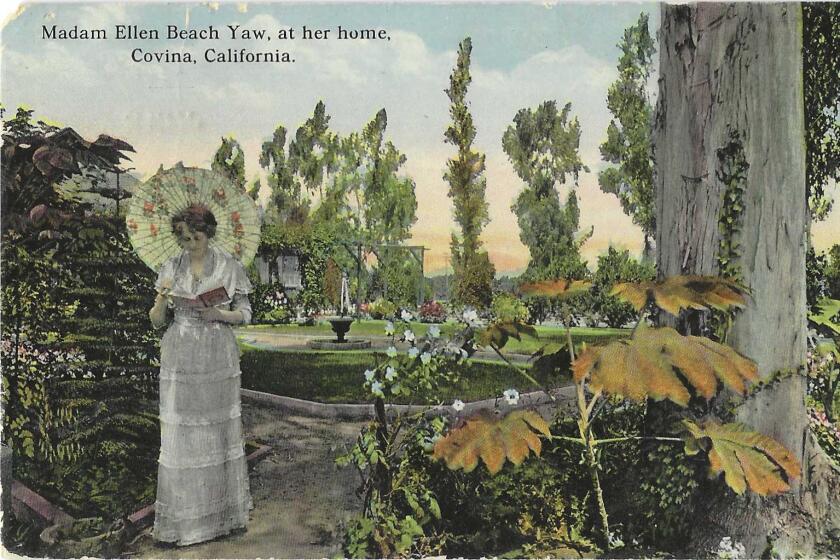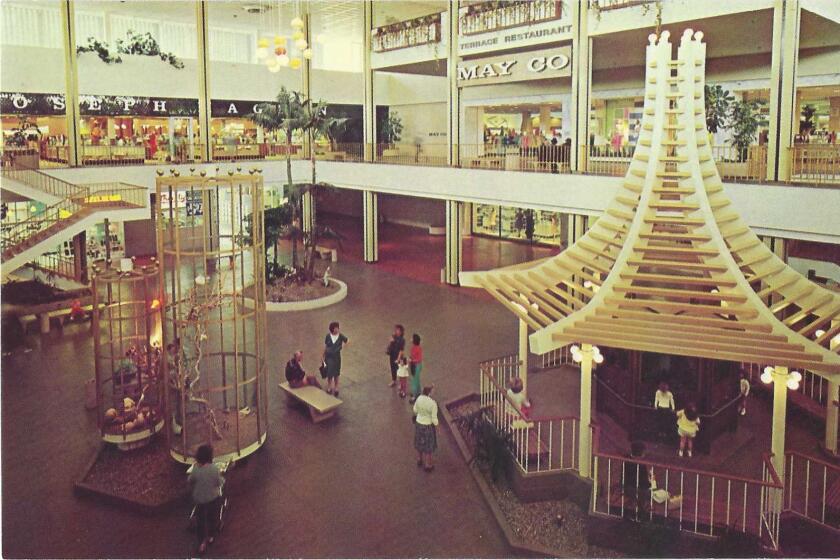Is that graffiti or art? How L.A. draws the lines

- Share via
Some acquaintances from Ireland were in town, and we were having lunch in their 20th-floor downtown hotel suite. I was being an armchair tour guide — out the windows, there’s L.A. Live, and back behind those skyscrapers, City Hall, by fiat once our tallest building.
One of them pointed and said, “What’s THAT?”
I didn’t even have to look.
“THAT” is Oceanwide Plaza, the Chinese-owned skyscraper project, dead in the water and half-finished for five years, its floors like unfrosted cake layers, inviting trespass and vandalism and all that vivid graffiti frosting. Any nimble-bodied person with sturdy legs and maybe a bail bondsman’s phone number could make the climb to join in turning the building into L.A.’s largest, brashest outdoor look-at-me canvas — like that Norman Mailer book title says, “Advertisements for Myself.”
Hard to make all of that make sense to the Irish visitors. But it’s L.A. in a nutshell.
Yes, we hate it, yes we love it, and yes, as is our habit, we let time mosey on by as we futz around over what to do.
Get the latest from Patt Morrison
Los Angeles is a complex place. Luckily, there's someone who can provide context, history and culture.
You may occasionally receive promotional content from the Los Angeles Times.
This city, supposedly the mural capital of the world, flaunts the title, fears it, is worthy and unworthy of it. And now we find ourselves wrangling again: Is art outside always outsider art? Or art at all?
One camp believes nothing can be art if it doesn’t have a nice frame around it and a price tag on it. Another camp believes that almost any spray-can concerto is art, and the sprayer an embryo Rembrandt. And there’s everyone else, somewhere in the middle.
At the beginning of this century, the city had a 10-year mural moratorium to sort out the chessboard mess of interests and counter-interests: how to keep murals thriving while keeping them from intruding illicitly into neighborhoods, how to keep businesses from simply ginning up wall-sized ads and calling them art, how to distinguish legal from illegal handiwork, and, frankly, good from bad. It’s a seesaw we’re still riding.
In two years, the world comes knocking at our door for the World Cup; then in another two, it’s the Olympics. Can we really not get our act together and dazzle them with something else world-class?
The first graffiti art I ever saw here were the river cats, Leo Limon’s whimsical feline faces on the storm drain openings into the Los Angeles River. They gave life — nine lives — to our rarely running cement eyesore.
Cemeteries -- grand and all-but-forgotten -- dot our landscape. Here are their stories -- and the stories of Angelenos who found their final rest there.
Next, I was thrilled by “Old Woman of the Freeway,” enormous and brilliant on a highway-facing wall, the presiding saint of the 101, painted by the master muralist Kent Twitchell. If traffic was moving well, she was the reason; if it wasn’t, she shared your stationary misery.
She was partly obscured by construction, then whitewashed for advertising space, restored by decree and killed off again by ugly graffiti. She was to have been revived in Sherman Oaks, but a property owner wouldn’t give Twitchell access — and one random local wildly claimed to see something “evil and satanic” in her blue eyes. She’s been restored to grandeur and safety on a wall at L.A. Valley College, her crocheted afghan flying like a kite.
Until the Whittier earthquake and a landlord put an end to it in 1987, the south wall of an 1880s building on Fair Oaks in Pasadena used to read: “ ‘My people are the people of the dessert,’ said T.E. Lawrence, picking up his fork.”
T.E. Lawrence was “Lawrence of Arabia,” the British officer and writer who took a vital role among the Arabs in World War I. So dessert/desert. A happenstance glance at it always made me laugh, and even now, I see the building and smile at its ghost.
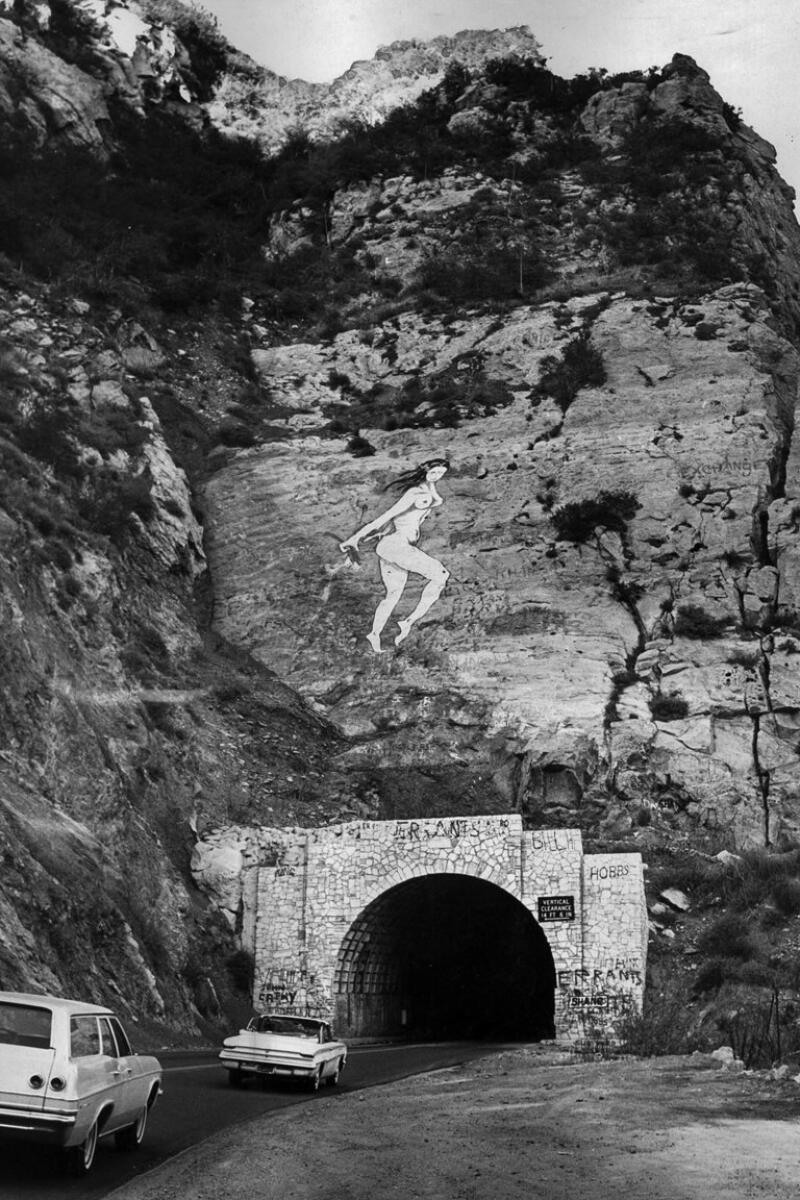
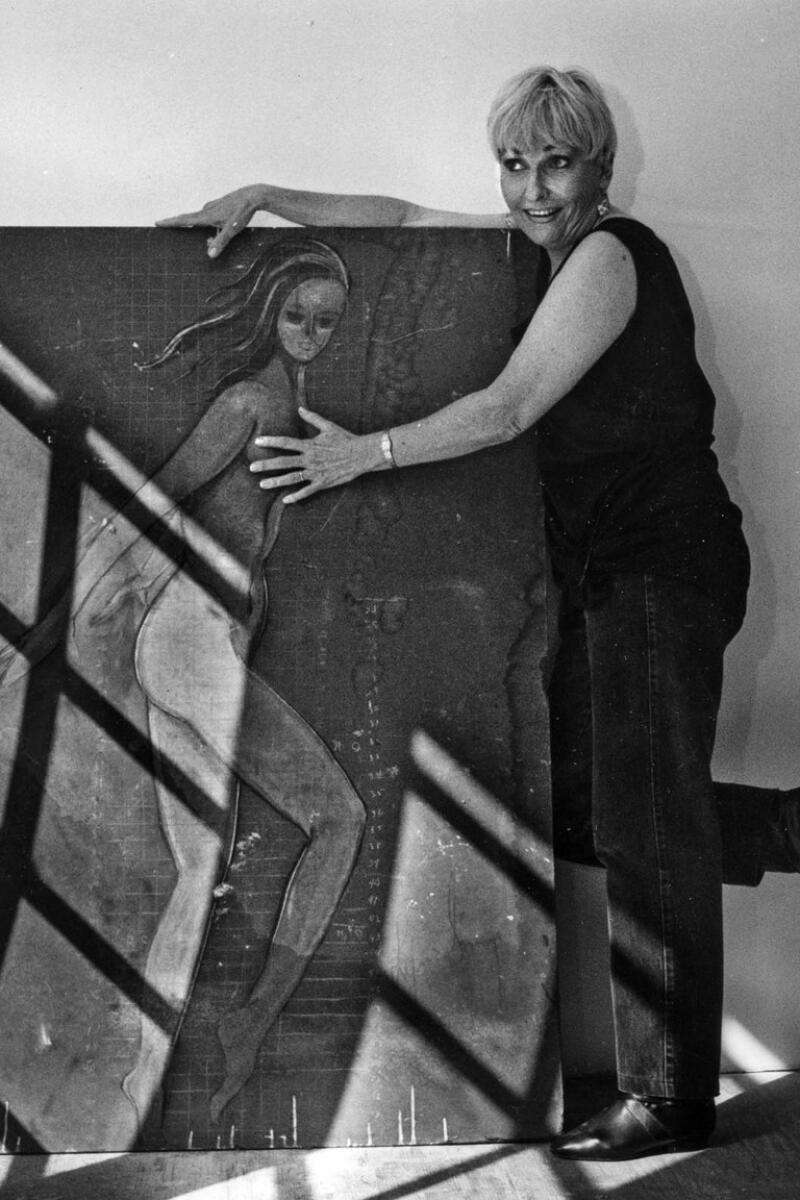
1. The Pink Lady of Malibu was controversial in her day. This photo appeared in the Nov. 1, 1966, Los Angeles Times. (George Fry / Los Angeles Times) 2. Lynne Westmore Bloom poses with a sketch she used as a model for the Pink Lady. This photo appeared in the Oct. 27, 1991, Los Angeles Times. (George Wilhelm / Los Angeles Times )
The one I wish I had seen was there and gone before I lived here: the Pink Lady of Malibu, exuberant, whimsical, utterly joyous. Hers is a tale of pink paint, bluenoses and brown coverup. She stood 60 feet tall above the tunnel on Malibu Canyon Road, and for nine months in the happening year of 1966, the Northridge artist Lynne Westmore Bloom slung on nylon ropes and climbed the rockface by full moonlight to erase the old graffiti, then to sketch and paint the lady. She was magnificent, pink-fleshed and naked, holding a nosegay of flowers, dark hair streaming as she strode across the cliff.
The bluenoses of L.A. County harrumphed. A traffic hazard! The earlier graffiti hadn’t seemed to bother them overmuch, but this? It took six days and 14 gallons of brown paint to obliterate the Pink Lady. Westmore got fired from her job, got death threats, got marriage proposals, and, along with her painted lady, got a permanent place in L.A. lore.
First California and then the federal government passed laws protecting murals and muralists, with complicated exceptions and requirements. California’s Art Preservation Act, in 1979, mandates “recognized quality,” a case-by-case judgment of experts. The federal Visual Artists Rights Act of 1990 has its own regulations. Kent Twitchell invoked both of these laws in a lawsuit after his mural of fellow artist Ed Ruscha was painted over in 2006. The matter was settled for $11 million.
Even these protections do nothing if the people who should be enforcing them don’t, or don’t even know about them. In 1999, an Eastside mural, “The Wall That Cracked Open,” was almost completely covered over in flat gray, evidently by a county anti-graffiti program. Artist Willie Herron had painted it on the wall of his uncle’s building in 1972 to memorialize his murdered little brother, John.
Multiply that incident by the hundreds. The supervisor of the county’s graffiti abatement program told The Times back then that she was unaware that the mural protection laws even existed. The city of L.A.’s anti-graffiti program chief said that her people have “very clear instructions not to paint over any murals. We find the artist and then we have the mural restored,” and often coated with a protective concoction so graffiti can be wiped off. Gang graffiti, it turns out, is as much a danger to mural art as overzealous, underinformed civic enforcers.
The credit as L.A.’s first known muralist goes to Einar Petersen, who ornamented mostly inside walls with historic, storytelling murals ordered up and paid for. He painted hundreds, murals of a jungle and of the Garden of Gethsemane at the old Clifton’s cafeteria, five panels of L.A. history at the Rosslyn Hotel — now, predictably, covered up, damaged, destroyed.
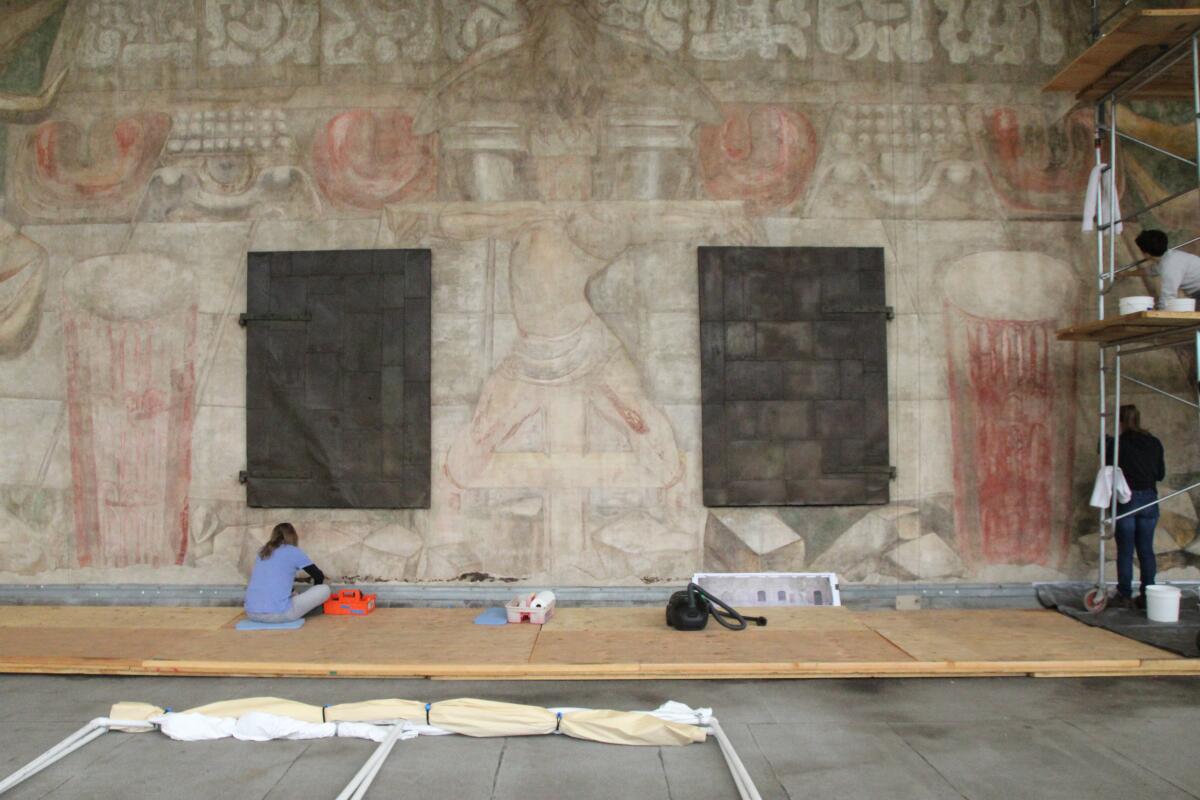
The present-day mural wars arguably began in 1932, over “América Tropical,” on Olvera Street, a work commissioned for L.A.’s Olympic year and painted by the renowned Mexican muralist David Alfaro Siqueiros.
Once the sponsors got an eyeful, they ordered the mural painted over. Its message was in its subtitle, and it was not subtle: “Oppressed and Destroyed by Imperialism,” a panorama not of contented campesinos but of tortured and tormented Latinos and Native Americans laboring under the policing eye of the U.S.
For decades after, the whitewashed wall carried its own kind of power, and Siqueiros knew it; it’s said that when its restoration was suggested in the 1960s, he was against it, because the force of censorship was maybe even more potent than the mural itself. It was at last conserved and displayed in 2012.
She toured the world wowing audiences, and she captured the public’s imagination for decades. No, not Taylor Swift; Ellen Beach Yaw, also known as Lark Ellen.
“América Tropical’s” spiritual child is Noni Olabisi’s relentless mural “To Protect and Serve.” The prolific Black muralist, who died a couple of years ago, painted the Jefferson Park work in 1997 and filled space with Black Panthers and celebrated Black radicals, helmeted police and hooded Klansmen. Its funding sidestepped public coffers to keep clear of the kind of censorship that had blotted out “América Tropical.”
SPARC helped to pay for Olabisi’s mural and is working to keep it spruced. The Social and Public Art Resource Center has spent almost five decades battering down the barricades between street art and what Siqueiros called “easel art,” standing up for “activist and socially relevant artwork.”
One of its co-founders is Judith Baca, whose monumental horizontal mural along the Tujunga Wash in the San Fernando Valley changed many Angelenos’ POV about graffiti art. Over more than a half-mile, “The Great Wall of Los Angeles” shows the histories of Californians whose stories are rarely told, and scores of young people turn out to join professionals to keep the 1978 mural perpetually refreshed.
Not far from there, around Pacoima’s city hall, you’ll find Mural Mile, block after block of artworks done with color, ingenuity, humor, passion and meaning, and changing all the time.
The Westside Pavilion is being remade as a UCLA biomedical research facility, an Orange County mall will become housing, and Gen Z seems to actually like shopping at malls.
A fellow named Banksy changed some minds about graffiti art too. The anonymous British artist chooses public spaces for his guerrilla work, and inadvertently created a paradox: His works can sell for millions, and people have been caught trying to get them off public walls to take to auction houses.
Banksy’s L.A. mural, 2010’s “Swing Girl,” is downtown, visible only from a deep alley between buildings — which is the point it makes about overbuilt places. The word painted on the wall is PARKING. Banksy almost whitewashed out the last three letters, and hanging from the first part, PARK, he painted a swing with a little girl perched on it.
It’s arguably graffiti, but not the kind that generates a gut-punch reaction among some Angelenos. For them, graffiti is a synonym for defacement and vandalism — and gangs marking out turf and messaging their enemies with menacing scribbles. Who wants to see those sinister scrawls creep into their neighborhoods?
Two incidents, both in the 1990s, caught the tone of Angelenos’ sentiments. One was the 1991 arrest of “Chaka,” who had written that name over and over, literally 10,000 times, on freeway bridges and signposts from Orange County to San Francisco. Then, 24 hours after he was let out of jail, he was caught in the downtown courthouse. He’d written CHAKA on an elevator door — on his way to see his probation officer. In 1996, after college scholarship and work offers, finding God and taking a job painting church buses for a Christian camp, he was arrested for tagging again.
A year later, a Woodland Hills teenager who’d been tagging above the San Diego Freeway fell 100 feet, fracturing his spine, both ankles and his left arm. Not everyone felt sorry for him. One Times letter writer summed up the sentiments of no small number of people: “I do not see the artistic expression involved in scrawling your street name across a piece of concrete like an animal marking its territory.”
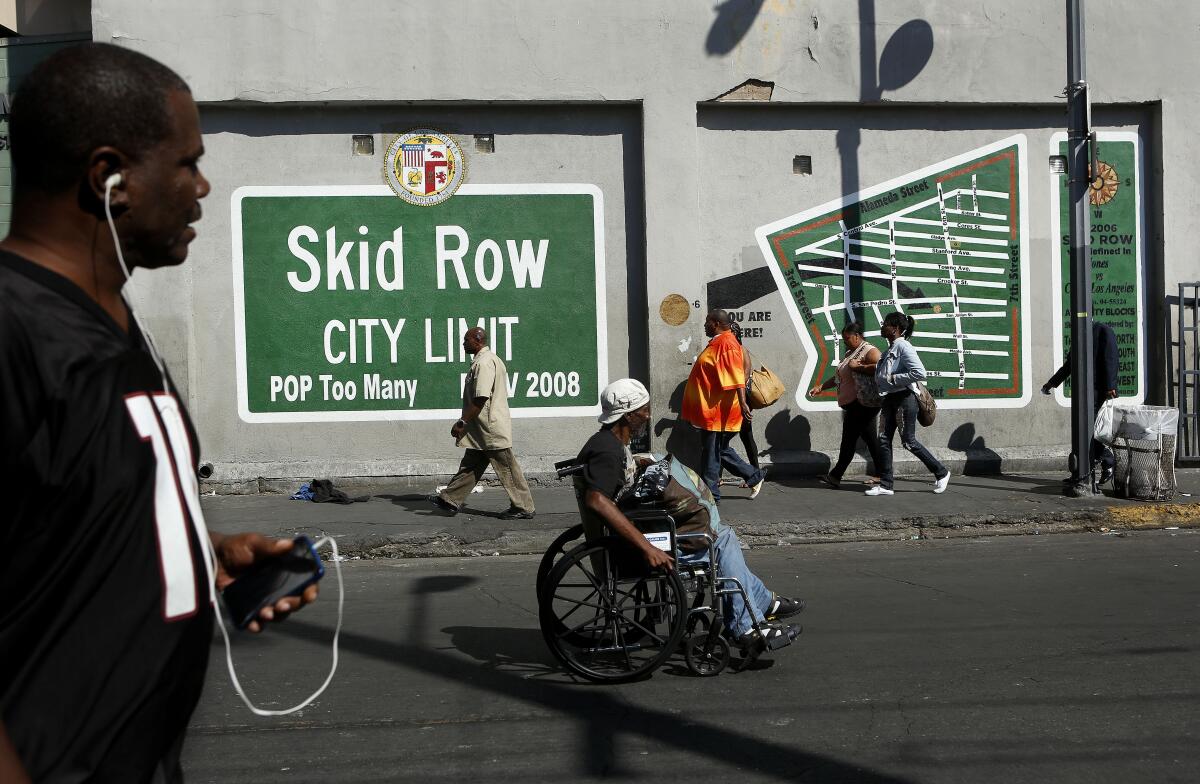
The best graffiti has something to teach, something to say, and that something is more than “my tagging crew is bad-assier than yours.” On Julian Street in Skid Row is the phenomenal Skid Row mural, paid for and painted by locals.
It is poignant and pointed.
It’s a mock-official, green and white sign, bearing the city seal, the words “SKID ROW CITY LIMIT” and at the bottom, “POP Too Many.”
A man — a writer named Charles Bukowski — who used to work up the road from Skid Row, sorting mail at the Terminal Annex, once wrote something that suits that image quite aptly. “An intellectual says a simple thing in a hard way. An artist says a hard thing in a simple way.”
Explaining L.A. With Patt Morrison
Los Angeles is a complex place. In this weekly feature, Patt Morrison is explaining how it works, its history and its culture.
More to Read
Sign up for Essential California
The most important California stories and recommendations in your inbox every morning.
You may occasionally receive promotional content from the Los Angeles Times.


